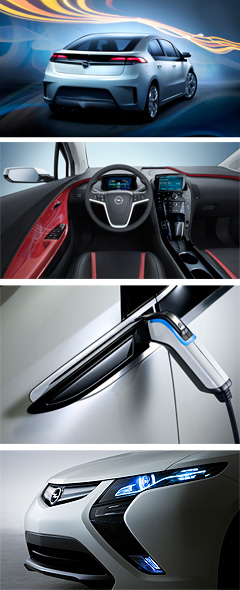Opel Ampera emerges from GM's Volt
BY MARTON PETTENDY | 4th Mar 2009

Biggest surprise is that the Opel Ampera’s aggressive new 2007 GTC concept-inspired bumpers and far more upmarket leather and piano-black interior are the only changes from the far more conservative Chevrolet Volt upon which it is based.
Revealed during GM’s 100th birthday celebrations last September, the production Volt was itself a significant departure from the wild sedan concept that first debuted at the 2007 Detroit motor show.
Indeed, while GM calls the front-drive, four-seater Volt a five-door sedan, Opel emphasises the fact it is a hatchback (although it is perhaps even more accurately described as a liftback), which of course is the body style of choice in Europe.
Either way, Australia’s Volt will be based on the less exciting Chevy Volt when it goes on sale here in 2012, with Holden using Friday’s Melbourne motor show opening to reveal images of what its lion-badged Volt will look like.
GM Europe confirmed the Ampera will go into production from late 2011 – a year after the Volt hits the US – and that a right-hand drive iteration will be sold as a Vauxhall in the UK in 2012, bringing to four the number of GM brands that have been confirmed to sell the Volt.
At this stage the Volt is planned for manufacture only at GM’s Detroit-Hamtramck Assembly plant in the US, but Vauxhall hopes to also eventually build it at its Ellesmere Port factory, which produces the Astra.

Apart from presenting the Ampera’s meaner face and more luxurious cabin, GM Europe also revealed that the car’s unique Voltec plug-in hybrid drive system, which is identical to the Volt’s and is also shared with the Detroit show’s Cadillac Converj concept, is capable of a petrol engine-assisted total range of more than 500km. It also has a claimed top speed of 161km/h.
GM Europe stresses that unlike an all-electric or ‘battery-electric vehicle’ (BEV), the Volt/Ampera eliminates “range anxiety” by providing drivers confidence they will not be stranded by a flat battery.
As such, GM describes the Volt/Ampera as an extended-range electric vehicle (E-REV), insisting that it differs from a plug-in hybrid in that it drives its wheels electrically at all times via an electric drive unit.
To be available with a plug-in function overseas from 2010, the Prius hybrid has an electric-only range that is much shorter than the Volt’s (60km) and uses electric and petrol power most of the time.
Nevertheless, the Voltec hardware still comprises a petrol engine (which in this case acts as a generator to charge the T-shaped 16-kWh lithium-ion battery pack only when required) and an (111kW/370Nm) electric motor, which are the two ingredients of a hybrid powertrain – albeit an advanced, next-generation plug-in hybrid.
GM last week confirmed it will invest about $US250 million ($A388m) to produce the new 1.4-litre ‘Family 0’ four-cylinder engine to power the Volt/Ampera and (in turbocharged guise) the Cruze sedan and next-generation Astra hatch, at its existing Flint South engine plant in Michigan. Production will begin in December 2010.
Holden’s Family II four-cylinder engine plant was to have closed at the end of 2009 after 28 years of operation, but that decision could be reversed if Holden can land the right to produce a new four-cylinder engine for next year’s locally built small car.
Holden will import the Korean-built Cruze sedan with 1.8-litre petrol and 2.0-litre diesel engines from the second quarter of 2009, but GoAuto understands its 2010 Delta-based small-car will be powered by GM’s new turbo-petrol engine.
The 17-inch alloy wheel-shod Opel Ampera’s dimensions are similar to the Volt’s at 4404mm long, 1798mm wide and 1430mm high, while its wheelbase and cargo space are identical at a respective 2685mm and 302 litres.
GM estimates that the Opel Ampera will save about 1700 litres of petrol based on 60km of driving daily and 22,000km a year, rising to 2200 litres for drivers who commute 100km a day or 36,500km a year.
The company is analysing the requirements of a recharging infrastructure for plug-in vehicles with energy companies including Spain’s Iberdrola, and used the Washington motor show on February 4 to outline its roadmap for a broad range of “stake-holders” to support plug-in vehicles in the US.
They include state, city and county governments, electric utilities, regulators and public utility commissions, permitting and code officials, ‘clean cities’ coalitions, local employers and universities.
The US federal government last October approved a $US7500 ($A11,648) tax incentive for consumers of plug-in vehicles, and the following month Californian cities San Francisco, San Jose and Oakland announced a plan for plug-in vehicle infrastructure and incentives.
GM said its next phase in getting the Volt ready for market would include “early-adopter” US cities like Washington and San Francisco.
Read more:
First look: Holden Volt emergesFirst look: Chev Volt morphs into Opel Ampera
GM to close old Fishermens Bend engine plant